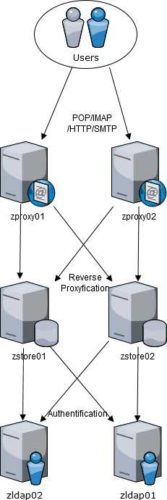Installation d’un cluster Zimbra à 6 serveurs
Introduction
Dans cet article, nous allons voir comment installer un cluster Zimbra à six noeuds étape par étape. La répartition des rôles au sein de ce cluster permettra de fournir une architecture résistante aux pannes dans les limites de ce qui est permis par Zimbra. L’installation se fera avec Zimbra version 8.8.15, l’installation ayant peu changé depuis au moins la version 7, il ne devrait pas y avoir de changements pour les versions à venir de la 8.8.
Les quatre grands rôles de serveur dans un cluster Zimbra sont les suivants :
- LDAP, en mode mono-serveur, master/slave ou multi master pour une haute disponibilité parfaite : stockage la configuration globale, des serveurs, des utilisateurs, l’authentification locale et les comptes de service. Sans LDAP, point de fonctionnement du cluster.
- Mailstore : contient les données des utilisateur. Chaque utilisateur est rattaché à un serveur. En cas d’indisponibilité d’un des mailstores, tous les utilisateurs du serveur sont impactés, il n’existe pas de HA au niveau mailstore.
- Proxy : Sert de point d’entrée pour les services POP/IMAP/HTTP, il masque pour l’utilisateur le serveur hébergeant réellement la boite. Ce rôle est typiquement placé dans une DMZ.
- MTA : effectue le routage SMTP des mails, aussi bien vers l’extérieur qu’en interne. Un mail à destination d’un utilisateur d’un même mailstore passe forcément par le SMTP. Par défaut, Amavis et Spamassassin sont activés pour le scan antispam et antivirus.
Nos serveurs seront les suivants :
- zldap01.int.morot.fr, rôle LDAP
- zldap02.int.morot.fr, rôle LDAP
- zproxy01.int.morot.fr, rôles Proxy et MTA
- zproxy02.int.morot.fr, rôles Proxy et MTA
- zstore01.int.morot.fr, rôle Mailstore
- zstore02.int.morot.fr, rôle Mailstore
Schématiquement, notre infrastructure ressemblera à ceci :
Pré-requis communs :
- Ubuntu 18.04 en installation minimale et à jour
- Un fichier /etc/hosts correctement renseigné avec le FQDN et l’adresse IP locale et pas uniquement la loopback
- Un volume LVM /opt/zimbra est recommandé en environnement de production pour permettre d’augmenter et séparer les volumes de données (voir de les redécouper selon les rôles, /opt/zimbra/backup, /opt/zimbra/store, etc…)
- Le service ssh actif et démarré
Sur chaque serveur on aura pris le soin de télécharger et extraire les sources d’installation :
wget https://files.zimbra.com/downloads/8.8.15_GA/zcs-8.8.15_GA_3869.UBUNTU18_64.20190918004220.tgz tar -zxvf zcs-8.8.15_GA_3869.UBUNTU18_64.20190918004220.tgz cd zcs-8.8.15_GA_3869.UBUNTU18_64.20190918004220/
Installation :
Le premier serveur Zimbra LDAP :
On lance l’installeur sur zldap01, le seul composant que l’on installe étant le zimbra-ldap :
./install.sh
[...]
Do you agree with the terms of the software license agreement? [N] Y
[...]
Use Zimbra's package repository [Y] Y
[...]
Select the packages to install
Install zimbra-ldap [Y] y
Install zimbra-logger [Y] n
Install zimbra-mta [Y] n
Install zimbra-dnscache [N] n
Install zimbra-snmp [Y] n
Install zimbra-store [Y] n
Install zimbra-apache [Y] n
Install zimbra-spell [Y] n
Install zimbra-memcached [Y] n
Install zimbra-proxy [Y] n
Checking required space for zimbra-core
Installing:
zimbra-core
zimbra-ldap
On valide les réglages. L’alerte sur le MX est normale, le domaine étant interne, il ne reçoit pas de mails et donc aucun MX n’est publié. Seul changement, le domaine créé par défaut correspond au nom d’hôte, on modifie pour que cela corresponde au suffixe DNS :
The system will be modified. Continue? [N] Y [...] DNS ERROR resolving MX for zldap01.int.morot.fr It is suggested that the domain name have an MX record configured in DNS Change domain name? [Yes] Create domain: [zldap01.int.morot.fr] int.morot.fr DNS ERROR resolving MX for int.morot.fr It is suggested that the domain name have an MX record configured in DNS Re-Enter domain name? [Yes] no done. Checking for port conflicts
En principe, s’agissant du premier serveur avec juste un rôle LDAP, il n’y a pas grand chose à retoucher sur le menu de post-installation :
Main menu 1) Common Configuration: 2) zimbra-ldap: Enabled s) Save config to file x) Expand menu q) Quit *** CONFIGURATION COMPLETE - press 'a' to apply Select from menu, or press 'a' to apply config (? - help) a Save configuration data to a file? [Yes] Save config in file: [/opt/zimbra/config.5317] Saving config in /opt/zimbra/config.5317...done. The system will be modified - continue? [No] Yes [...] Notify Zimbra of your installation? [Yes] No [...]
C’est tout, notre serveur LDAP est créé. Pour ajouter notre second serveur, on active la réplication LDAP :
su - zimbra zimbra@zldap01:~$ libexec/zmldapenablereplica Enabling sync provider on master...succeeded
Installation du LDAP slave :
Pour installer notre serveur LDAP Slave, nous aurons besoin :
- du mot de passe LDAP Master
- du mot de passe LDAP replication
Pour les obtenir depuis zldap01 :
zimbra@zldap01:~$ zmlocalconfig -s ldap_root_password ldap_root_password = fZhYOIWPu zimbra@zldap01:~$ zmlocalconfig -s ldap_replication_password ldap_replication_password = fZhYOIWPu
On relance le processus d’installation et comme pour le master, le seul package à installer est zibmra-ldap :
Select the packages to install
Install zimbra-ldap [Y] Y
[...]
Checking required space for zimbra-core
Installing:
zimbra-core
zimbra-ldap
The system will be modified. Continue? [N] Y
[...]
DNS ERROR resolving MX for zldap02.int.morot.fr
It is suggested that the domain name have an MX record configured in DNS
Change domain name? [Yes] No
done.
Checking for port conflicts
Une fois arrivé au menu de configuration, dans la common configuration il faut définir deux éléments :
- Le LDAP master host, zldap01.int.morot.fr dans notre cas
- Le Ldap Admin password (zmlocalconfig -s ldap_root_password)
La configuration de ces deux éléments sera naturellement à répéter sur les autres noeuds Zimbra.
Ceci a pour effet de raccrocher notre serveur au cluster démarré par le premier serveur LDAP au lieu d’instancier un serveur distinct.
Select, or 'r' for previous menu [r]
Main menu
1) Common Configuration:
+Hostname: zldap02.int.morot.fr
+Ldap master host: zldap01.int.morot.fr
+Ldap port: 389
******* +Ldap Admin password: Not Verified
+Store ephemeral attributes outside Ldap: no
+Secure interprocess communications: yes
+TimeZone: UTC
+IP Mode: ipv4
+Default SSL digest: sha256
2) zimbra-ldap: Enabled
+Create Domain: yes
+Domain to create: zldap02.int.morot.fr
+Ldap replication type: replica
+Ldap root password: set
******* +Ldap replication password: Not Verified
s) Save config to file
x) Expand menu
q) Quit
Nous pouvons ensuite aller dans le menu zimbra-ldap pour désactiver la création d’un domaine et surtout définir le mot de passe Ldap replication password (zmlocalconfig -s ldap_replication_password) :
Address unconfigured (**) items and enable ldap replication on ldap master (? - help) 2 Ldap configuration 1) Status: Enabled 2) Create Domain: no 3) Ldap replication type: replica 4) Ldap root password: set ** 5) Ldap replication password: Not Verified Select, or 'r' for previous menu [r] 5 Password for ldap replication user (min 6 characters): [lQEkl46kG] fZhYOIWPu
Si tout est en ordre, aucun item n’est préfixé d’une étoile et nous pouvons appliquer la configuration.
Main menu 1) Common Configuration: 2) zimbra-ldap: Enabled s) Save config to file x) Expand menu q) Quit *** CONFIGURATION COMPLETE - press 'a' to apply Select from menu, or press 'a' to apply config (? - help) a Save configuration data to a file? [Yes] Save config in file: [/opt/zimbra/config.5122] Saving config in /opt/zimbra/config.5122...done. The system will be modified - continue? [No] Yes [...] Notify Zimbra of your installation? [Yes] No
Vérifions que notre cluster comporte bien un second serveur :
su - zimbra zimbra@zldap02:~$ zmprov gas zldap01.int.morot.fr zldap02.int.morot.fr
Installation des serveurs Proxy/MTA :
L’installation des deux serveurs proxy/mta est identique sur les deux zproxy.
Pour installer nos serveurs ProxyLDAP, nous aurons besoin :
- du mot de passe LDAP Master
- du mot de passe LDAP Postfix
- du mot de passe LDAP Nginx
- du mot de passe LDAP Amavis
Pour les obtenir depuis zldap01 :
zimbra@zldap01:~$ zmlocalconfig -s ldap_root_password ldap_root_password = fZhYOIWPu zimbra@zldap01:~$ zmlocalconfig -s ldap_postfix_password ldap_postfix_password = fZhYOIWPu zimbra@zldap01:~$ zmlocalconfig -s ldap_amavis_password ldap_amavis_password = fZhYOIWPu zimbra@zldap01:~$ zmlocalconfig -s ldap_nginx_password ldap_nginx_password = fZhYOIWPu
On relance le processus d’installation et comme pour le master, les seuls packages à installer sont zibmra-mta, zimbra-proxy et zimbra-memcached :
./install.sh
[...]
Do you agree with the terms of the software license agreement? [N] Y
[...]
Use Zimbra's package repository [Y]
[...]
Select the packages to install
Install zimbra-ldap [Y] n
Install zimbra-logger [Y] n
Install zimbra-mta [Y] Y
Install zimbra-dnscache [Y] n
Install zimbra-snmp [Y] n
Install zimbra-store [Y] n
Install zimbra-apache [Y] n
Install zimbra-spell [Y] n
Install zimbra-memcached [Y] Y
Install zimbra-proxy [Y] Y
Checking required space for zimbra-core
Installing:
zimbra-core
zimbra-mta
zimbra-memcached
zimbra-proxy
zimbra-mta-patch
zimbra-proxy-patch
Une fois arrivé au menu de configuration, dans la common configuration il faut définir ces éléments :
- Le LDAP master host, zldap01.int.morot.fr dans notre cas
- Le Ldap Admin password (zmlocalconfig -s ldap_root_password)
Common configuration 1) Hostname: zproxy02.int.morot.fr 2) Ldap master host: zldap01.int.morot.fr 3) Ldap port: 389 4) Ldap Admin password: set 5) LDAP Base DN: cn=zimbra 6) Store ephemeral attributes outside Ldap: yes 7) Value for zimbraEphemeralBackendURL: ldap://default 8) Secure interprocess communications: yes 9) TimeZone: UTC 10) IP Mode: ipv4 11) Default SSL digest: sha256 Select, or 'r' for previous menu [r]
Dans la configuration zimbra-mta il faut définir ces éléments :
- Notification address for AV alerts:, admin@DOMAINE, admin@int.morot.fr ici
- Le Bind password for postfix ldap user: (zmlocalconfig -s ldap_postfix_password)
- Le Bind password for amavisldap user: (zmlocalconfig -s ldap_amavis_password)
Mta configuration 1) Status: Enabled 2) Enable Spamassassin: yes 3) Enable Clam AV: yes 4) Enable OpenDKIM: yes 5) Notification address for AV alerts: admin@int.morot.fr 6) Bind password for postfix ldap user: set 7) Bind password for amavis ldap user: set Select, or 'r' for previous menu [r]
Dans la configuration zimbra-proxy il faut définir ces éléments :
- Le Bind password for nginx ldap user: (zmlocalconfig -s ldap_nginx_password)
- Le Proxy server mode à redirect afin que les communications http soient redirigées en https, par défaut uniquement https.
Proxy configuration 1) Status: Enabled 2) Enable POP/IMAP Proxy: TRUE 3) Enable strict server name enforcement? TRUE 4) IMAP server port: 7143 5) IMAP server SSL port: 7993 6) IMAP proxy port: 143 7) IMAP SSL proxy port: 993 8) POP server port: 7110 9) POP server SSL port: 7995 10) POP proxy port: 110 11) POP SSL proxy port: 995 12) Bind password for nginx ldap user: set 13) Enable HTTP[S] Proxy: TRUE 14) Web server HTTP port: 8080 15) Web server HTTPS port: 8443 16) HTTP proxy port: 80 17) HTTPS proxy port: 443 18) Proxy server mode: redirect Select, or 'r' for previous menu [r]
Installation des serveurs Mailstore :
L’installation des deux serveurs proxy/mta est identique sur les deux zproxy.
Pour installer nos serveurs Mailstore, nous aurons besoin :
- du mot de passe LDAP Master
Sur le mailstore zstore01 uniquement, le package zimbra-logger sera déployé. Il s’agit d’un rôle unique au sein du cluster.
./install.sh
[...]
Do you agree with the terms of the software license agreement? [N] Y
[...]
Use Zimbra's package repository [Y]
[...]
Select the packages to install
Install zimbra-ldap [Y] n
Install zimbra-logger [Y] Y
Install zimbra-mta [Y] n
Install zimbra-dnscache [N] n
Install zimbra-snmp [Y] n
Install zimbra-store [Y] y
Install zimbra-apache [Y] y
Install zimbra-spell [Y] y
Install zimbra-memcached [Y] n
Install zimbra-proxy [Y] n
Install zimbra-drive [Y] n
Install zimbra-imapd (BETA - for evaluation only) [N] n
Install zimbra-chat [Y] n
Checking required space for zimbra-core
Checking space for zimbra-store
Checking required packages for zimbra-store
zimbra-store package check complete.
Installing:
zimbra-core
zimbra-logger
zimbra-store
zimbra-apache
zimbra-spell
zimbra-patch
The system will be modified. Continue? [N] Y
Une fois arrivé au menu de configuration, dans la common configuration il faut définir ces éléments :
- Le LDAP master host, zldap01.int.morot.fr dans notre cas
- Le Ldap Admin password (zmlocalconfig -s ldap_root_password)
Une fois arrivé au menu de configuration, dans la common configuration il faut définir ces éléments :
- Le LDAP master host, zldap01.int.morot.fr dans notre cas
- Le Ldap Admin password (zmlocalconfig -s ldap_root_password)
Common configuration 1) Hostname: zstore01.int.morot.fr 2) Ldap master host: zldap01.int.morot.fr 3) Ldap port: 389 4) Ldap Admin password: set 5) LDAP Base DN: cn=zimbra 6) Store ephemeral attributes outside Ldap: yes 7) Value for zimbraEphemeralBackendURL: ldap://default 8) Secure interprocess communications: yes 9) TimeZone: UTC 10) IP Mode: ipv4 11) Default SSL digest: sha256 Select, or 'r' for previous menu [r]
Dans la configuration zimbra-store il faut définir ces éléments :
- Create admin user : yes sur le premier store uniquement et définir l’admin password
- SMTP Host : zproxy01.int.morot.fr sur zstore01 et zproxy02.int.morot.fr sur zstore02 afin de répartir les flux
- Enable version update checks: false
- Enable version update notifications: false
- Web server mode: both
Main menu
1) Common Configuration:
2) zimbra-logger: Enabled
3) zimbra-store: Enabled
+Create Admin User: yes
+Admin user to create: admin@int.morot.fr
******* +Admin Password UNSET
+Anti-virus quarantine user: virus-quarantine.preuvqpomh@int.morot.fr
+Enable automated spam training: yes
+Spam training user: spam.wri9hfsc@int.morot.fr
+Non-spam(Ham) training user: ham.jzjjcurd@int.morot.fr
******* +SMTP host: UNSET
+Web server HTTP port: 8080
+Web server HTTPS port: 8443
+HTTP proxy port: 80
+HTTPS proxy port: 443
+Web server mode: https
+IMAP server port: 7143
+IMAP server SSL port: 7993
+IMAP proxy port: 143
+IMAP SSL proxy port: 993
+POP server port: 7110
+POP server SSL port: 7995
+POP proxy port: 110
+POP SSL proxy port: 995
+Use spell check server: yes
+Spell server URL: http://zstore01.int.morot.fr:7780/aspell.php
+Configure for use with mail proxy: TRUE
+Configure for use with web proxy: TRUE
+Enable version update checks: TRUE
+Enable version update notifications: TRUE
+Install mailstore (service webapp): yes
+Install UI (zimbra,zimbraAdmin webapps): yes
Postinstallation du cluster
Le logger :
Le service logger centralise des statistiques et génère des graphiques de fonctionnement (assez moches…) du cluster Zimbra. Sur une infrastructure importante, c’est un goulot d’étranglement qu’il vaut mieux ne pas déployer, sur un cluster 6 serveurs, cela reste gérable. SSur zmstore01 qui a le rôle logger, nous allons autoriser la réception syslog via le réseau.
vim /etc/rsyslog.conf
Décommenter cette section pour permettre la réception de logs depuis le réseau :
# provides UDP syslog reception module(load="imudp") input(type="imudp" port="514")
Et on redémarre syslog :
systemctl restart rsyslog.service
Puis sur tous les serveurs en root, on lance la commande suivante qui aura pour effet de configurer le syslog de chaque serveur pour l’envoi vers le logger :
/opt/zimbra/libexec/zmsyslogsetup
Finalisation des configurations :
Sur tous les serveurs, on interdit le redémarrage non contrôlé des services. En effet, zmconfigd monitore les changements de configuration et a tendance à redémarrer les services en mode kamikaze.
zmlocalconfig -e "zmconfigd_enable_config_restarts=false"
Sur tous les serveurs on désactive les communications TLS avec leserveur LDAP pour des raisons de performance :
zmlocalconfig -e "zimbra_require_interprocess_security=0" zmlocalconfig -e ldap_common_require_tls=0 zmlocalconfig -e ldap_starttls_required=falseSur tous les serveurs on pousse localement les clés SSH pour les communications inter serveur qui passe par ce protocole en exécutant cette commande :
zimbra@zldap01:~$ zmupdateauthkeys Updating keys for zldap01.int.morot.fr Fetching key for zldap01.int.morot.fr Updating keys for zldap01.int.morot.fr Updating keys for zldap02.int.morot.fr Fetching key for zldap02.int.morot.fr Updating keys for zldap02.int.morot.fr Updating keys for zproxy01.int.morot.fr Fetching key for zproxy01.int.morot.fr Updating keys for zproxy01.int.morot.fr Updating keys for zproxy02.int.morot.fr Fetching key for zproxy02.int.morot.fr Updating keys for zproxy02.int.morot.fr Updating keys for zstore01.int.morot.fr Fetching key for zstore01.int.morot.fr Updating keys for zstore01.int.morot.fr Updating keys for zstore02.int.morot.fr Fetching key for zstore02.int.morot.fr Updating keys for zstore02.int.morot.fr Updating /opt/zimbra/.ssh/authorized_keysRépartition de charge :
On répartit les flux LDAP :
zldap01, zproxy01, zstore01 :
zmlocalconfig -e "ldap_url=ldap://zldap01.int.morot.fr:389 ldap://zldap02.int.morot.fr:389"zldap02, zproxy02, zstore02 :
zmlocalconfig -e "ldap_url=ldap://zldap02.int.morot.fr:389 ldap://zldap01.int.morot.fr:389"On répartit les flux smtp depuis les stores (pour le flux entrant il suffit d'utiliser la même pondération MX).
Sur zstore01 :
zmprov ms ` zmhostname ` zimbraSmtpHostname "zproxy01.int.morot.fr" zmprov ms ` zmhostname ` +zimbraSmtpHostname "zproxy02.int.morot.fr"Sur zstore02 :
zmprov ms ` zmhostname ` zimbraSmtpHostname "zproxy02.int.morot.fr" zmprov ms ` zmhostname ` +zimbraSmtpHostname "zproxy01.int.morot.fr"Reverse proxyfication des stores :
Sur nos deux stores on s'assure d'être reverse proxyfié :
zmprov ms `zmhostname ` zimbraMailReferMode "reverse-proxied"Sur les deux proxy on applique une communication en clair entre proxy et store pour des raisons de performance en considérant le réseau suffisamment sûr :
zmprov ms ` zmhostname ` zimbraReverseProxySSLToUpstreamEnabled FALSERedémarrage final :
Enfin, on redémarre tous les serveurs avec dans l'ordre LDAP Master, LDAP Slave puis les Proxy/Store :
zmcontrol restartOptionnel : LDAP Multi-Master :
Sur notre serveur LDAP maître on active la réplication LDAP MMR pour zldap02 :
./libexec/zmldapenable-mmr -s 1 -m ldap://zldap02.int.morot.fr:389/ zmlocalconfig -e ldap_master_url="ldap://zldap01.int.morot.fr:389 ldap://zldap02.int.morot.fr:389" zmlocalconfig -e ldap_url="ldap://zldap01.int.morot.fr:389 ldap://zldap02.int.morot.fr:389" zmcontrol restartOn promouvoie notre LDAP slave zldap02 :/opt/zimbra/libexec/zmldappromote-replica-mmr -s 2 zmlocalconfig -e ldap_master_url="ldap://zldap02.int.morot.fr:389 ldap://zldap011.int.morot.fr:389" zmcontrol restartOn vérifie notre réplication, les CSN doivent correspondrent :
zimbra@zldap02:~$ libexec/zmreplchk Master: ldap://zldap02.int.morot.fr:389 ServerID: 2 Code: 0 Status: In Sync CSNs: 20200206163012.698628Z#000000#001#000000 Master: ldap://zldap011.int.morot.fr:389 ServerID: Code: 4 Status: Server down Replica: ldap://zldap01.int.morot.fr:389 Code: 0 Status: In Sync CSNs: 20200206163012.698628Z#000000#001#000000Enfin, il reste à modifier nos url LDAP sur chaque serveur, en croisant les serveur pour permettre une répartition de charge optimale.
Sur zproxy01 et zstore01 :
zmlocalconfig -e ldap_master_url="ldap://zldap01.int.morot.fr:389 ldap://zldap02.int.morot.fr:389" zmlocalconfig -e ldap_url="ldap://zldap01.int.morot.fr:389 ldap://zldap02.int.morot.fr:389 " zmcontrol restartSur zproxy02 et zstore02 :
zmlocalconfig -e ldap_master_url="ldap://zldap02.int.morot.fr:389 ldap://zldap01.int.morot.fr:389" zmlocalconfig -e ldap_url="ldap://zldap02.int.morot.fr:389 ldap://zldap01.int.morot.fr:389 " zmcontrol restartUne classe de service :
Les classes de service servent à indiquer les fonctionnalités et paramètres par défaut des comptes. Nous allons créer une classe stdMailAccount pour nos boites mail et laisser la COS (Class of service) default intacte et les comptes créés sur cette COS seront répartis aléatoirement entre les deux stores.
zimbra@zstore01:~$ zmprov cpc default stdMailAccount c2d3cad7-5cbf-42e9-aa19-a8cfb7fc6f03 zimbra@zstore01:~$ zmprov gs zstore01.int.morot.fr zimbraId # name zstore01.int.morot.fr zimbraId: e31ae88f-9a15-4988-9a12-81acaa08cfea zimbra@zstore01:~$ zmprov gs zstore02.int.morot.fr zimbraId # name zstore02.int.morot.fr zimbraId: dbbb31b0-7d4e-4e72-b513-b166257e739b zimbra@zstore01:~$ zmprov mc stdMailAccount zimbraMailHostPool e31ae88f-9a15-4988-9a12-81acaa08cfea zimbra@zstore01:~$ zmprov mc stdMailAccount +zimbraMailHostPool dbbb31b0-7d4e-4e72-b513-b166257e739bEnfin, nous allons pousser à titre d'exemple certains paramètres :
zimbra@zstore01:~$ zmprov mc stdMailAccount zimbraDumpsterEnabled TRUE zimbra@zstore01:~$ zmprov mc stdMailAccount zimbraMailQuota 10485760 zimbra@zstore01:~$ zmprov mc stdMailAccount zimbraPrefCalendarFirstDayOfWeek 1 zimbra@zstore01:~$ zmprov mc stdMailAccount zimbraPrefGroupMailBy message zimbra@zstore01:~$ zmprov mc stdMailAccount zimbraMaxMailItemsPerPage 100 zmprov mc stdMailAccount zimbraPrefTimeZoneId "GMT+01.00) Brussels / Copenhagen / Madrid / Paris"Configuration de notre domaine :
On attribue notre COS précédente comme COS par défaut pour tous les nouveaux comptes du domaine int.morot.fr.
zimbra@zstore01:~$ zmprov gc stdMailAccount zimbraId # name stdmailaccount zimbraId: c2d3cad7-5cbf-42e9-aa19-a8cfb7fc6f03 zimbra@zstore01:~$ zmprov md int.morot.fr zimbraDomainDefaultCOSId c2d3cad7-5cbf-42e9-aa19-a8cfb7fc6f03Et accessoirement, nous allons masquer les stores des URL (des partages notamment...) en affectant une URL d'accès qui doit exister dans le DNS.
zimbra@zstore01:~$ zmprov md int.morot.fr zimbraPublicServiceHostname webmail.int.morot.fr















